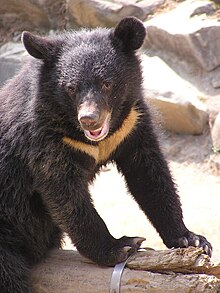
The Taiwan blue magpie, also called the Taiwan magpie, Formosan blue magpie, or the "long-tailed mountain lady", is a bird species in the crow family. It is endemic to Taiwan.
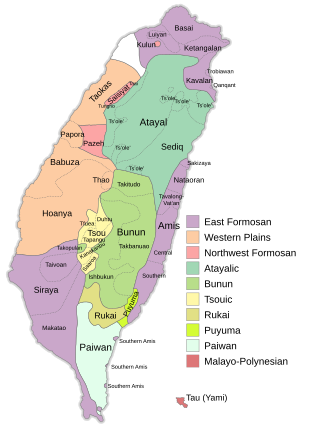
The Formosan languages are a geographic grouping comprising the languages of the indigenous peoples of Taiwan, all of which are Austronesian. They do not form a single subfamily of Austronesian but rather up to nine separate primary subfamilies. The Taiwanese indigenous peoples recognized by the government are about 2.3% of the island's population. However, only 35% speak their ancestral language, due to centuries of language shift. Of the approximately 26 languages of the Taiwanese indigenous peoples, at least ten are extinct, another four are moribund, and all others are to some degree endangered.

The Asian black bear, also known as the Indian black bear, Asiatic black bear, moon bear and white-chested bear, is a medium-sized bear species native to Asia that is largely adapted to an arboreal lifestyle. It lives in the Himalayas, southeastern Iran, the northern parts of the Indian subcontinent, Mainland Southeast Asia, the Korean Peninsula, China, the Russian Far East, the islands of Honshū and Shikoku in Japan, and Taiwan. It is listed as vulnerable on the IUCN Red List, and is threatened by deforestation and poaching for its body parts, which are used in traditional medicine.
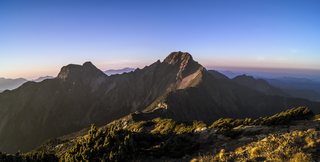
Yu Shan or Yushan, also known as Mount Jade, Jade Mountain, Tongku Saveq or Mount Niitaka during Japanese rule, is the highest mountain in Taiwan at 3,952 m (12,966 ft) above sea level, giving Taiwan the 4th-highest maximum elevation of any island in the world. It is the highest point in the western Pacific region outside of the Kamchatka Peninsula. Yushan and its surrounding mountains belong to the Yushan Range. The area was once in the ocean; it rose to its current height because of the Eurasian Plate's movement over the Philippine Sea Plate. Yushan is ranked 40th by topographic isolation.
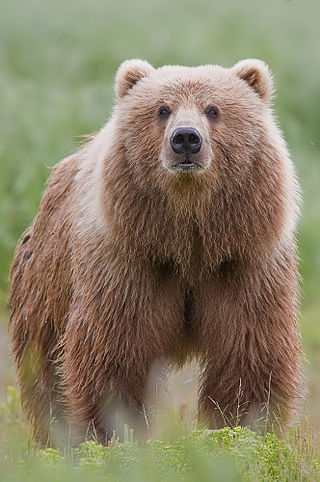
The Kodiak bear, also known as the Kodiak brown bear, sometimes the Alaskan brown bear, inhabits the islands of the Kodiak Archipelago in southwest Alaska. It is one of the largest recognized subspecies or population of the brown bear, and one of the two largest bears alive today, the other being the polar bear. They are also considered by some to be a population of grizzly bears.

The Formosan clouded leopard is a clouded leopard population that was endemic to Taiwan. Camera trapping studies carried out in several protected areas in Taiwan between 1997 and 2012 did not record any clouded leopard. The population is listed as extinct on the IUCN Red List.

Yushan National Park is one of the nine national parks in Taiwan and was named after the summit Yushan, the highest peak of the park. The park covers a total area of 103,121 hectares that includes large sections of the Central Mountain Range. The park contains more than thirty peaks over 3,000 metres (9,843 ft) in elevation, and two-thirds of the area within the park is above 2,000 metres (6,562 ft). The elevation difference in the park is 3,600 metres (11,811 ft), and there are many canyons, cliffs, and valleys.

An ursid hybrid is an animal with parents from two different species or subspecies of the bear family (Ursidae). Species and subspecies of bear known to have produced offspring with another bear species or subspecies include American black bears, grizzly bears, and polar bears, all of which are members of the genus Ursus. Bears not included in Ursus, such as the giant panda, are expected to be unable to produce hybrids with other bears. The giant panda bear belongs to the genus Ailuropoda.

Saaroa or Lhaʼalua is a Southern Tsouic language spoken by the Saaroa (Hla'alua) people, an indigenous people of Taiwan. It is a Formosan language of the Austronesian family.

The Taiwan subtropical evergreen forests is an ecoregion that covers most of the island of Taiwan, with the exception of the southern tip of the island, which constitutes the South Taiwan monsoon rain forests ecoregion. The island's concentrated steep mountains host a range of forest types, from subtropical forests in the lowlands to temperate and alpine or montane forests.

The Taiwanese serow also known as the Formosan serow, is a small bovid that is endemic to the island of Taiwan.

The Florida black bear is a subspecies of the American black bear that has historically ranged throughout most of Florida and the southern portions of Georgia, Alabama, and Mississippi. The large black-furred bears live mainly in forested areas and have seen recent habitat reduction throughout the state due to increased human development, as well as habitat modifications within bear habitat.

The Ussuri brown bear, also known as the Ezo brown bear, Russian grizzly bear, or the black grizzly bear, is a subspecies of the brown bear or a population of the Eurasian brown bear. One of the largest brown bears, a very large Ussuri brown bear may approach the Kodiak bear in size. It is not to be confused with the North American grizzly bear.

The Balochistanblack bear is a subspecies of the Asian black bear occurring in the Balochistan Mountains of southern Pakistan and Iran. It has an unusually thin coat for an Asian black bear, but this is because it is found in a warmer climate than most of the other subspecies, which are found in the much colder Himalayan Mountains. It is also more frugivorous than the other subspecies, and it loves to eat figs and bananas.
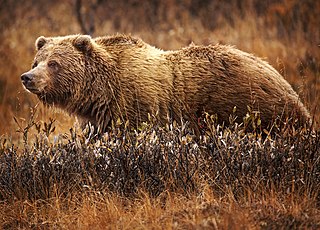
The grizzly bear, also known as the North American brown bear or simply grizzly, is a population or subspecies of the brown bear inhabiting North America.
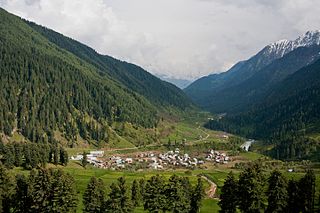
The Overa-Aru Wildlife Sanctuary is a protected area in Aru Valley, Pahalgam near Anantnag city in Anantnag district of Jammu and Kashmir, India. It lies 46 km from Anantnag city, the district headquarter. It is on the periphery of the two villages of Overa and Aru. The sanctuary spreads over 511 square kilometres (197 sq mi), lies 76 kilometres (47 mi) east of Srinagar. It was declared a game reserve in 1945 under the Dogra Rule and later upgraded to a sanctuary in 1981.

Spodiopogon formosanus or the Taiwan oil millet is a species of perennial grass in the family Poaceae. It is endemic to Taiwan. It is traditionally grown as a cereal crop by the Taiwanese aborigines.
Phu Pha Daeng Wildlife Sanctuary is a wildlife sanctuary in Lom Sak District of Thailand's Phetchabun Province. The sanctuary covers an area of 235 square kilometres (91 sq mi) and was established in 1999.
